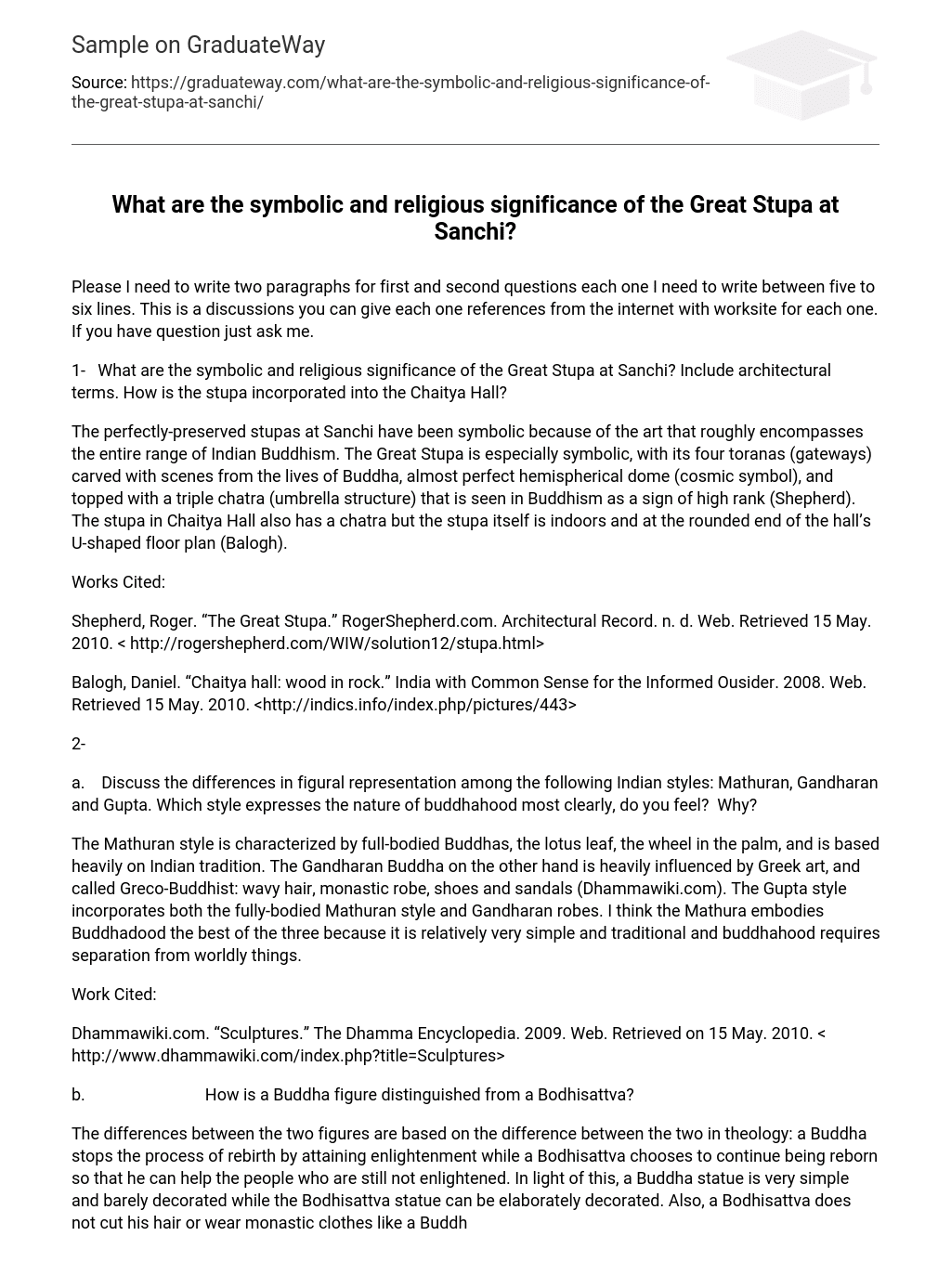Please I need to write two paragraphs for first and second questions each one I need to write between five to six lines. This is a discussions you can give each one references from the internet with worksite for each one. If you have question just ask me.
1- What are the symbolic and religious significance of the Great Stupa at Sanchi? Include architectural terms. How is the stupa incorporated into the Chaitya Hall?
The perfectly-preserved stupas at Sanchi have been symbolic because of the art that roughly encompasses the entire range of Indian Buddhism. The Great Stupa is especially symbolic, with its four toranas (gateways) carved with scenes from the lives of Buddha, almost perfect hemispherical dome (cosmic symbol), and topped with a triple chatra (umbrella structure) that is seen in Buddhism as a sign of high rank (Shepherd). The stupa in Chaitya Hall also has a chatra but the stupa itself is indoors and at the rounded end of the hall’s U-shaped floor plan (Balogh).
Works Cited:
Shepherd, Roger. “The Great Stupa.” RogerShepherd.com. Architectural Record. n. d. Web. Retrieved 15 May. 2010. < http://rogershepherd.com/WIW/solution12/stupa.html>
Balogh, Daniel. “Chaitya hall: wood in rock.” India with Common Sense for the Informed Ousider. 2008. Web. Retrieved 15 May. 2010. <http://indics.info/index.php/pictures/443>
2-
a. Discuss the differences in figural representation among the following Indian styles: Mathuran, Gandharan and Gupta. Which style expresses the nature of buddhahood most clearly, do you feel? Why?
The Mathuran style is characterized by full-bodied Buddhas, the lotus leaf, the wheel in the palm, and is based heavily on Indian tradition. The Gandharan Buddha on the other hand is heavily influenced by Greek art, and called Greco-Buddhist: wavy hair, monastic robe, shoes and sandals (Dhammawiki.com). The Gupta style incorporates both the fully-bodied Mathuran style and Gandharan robes. I think the Mathura embodies Buddhadood the best of the three because it is relatively very simple and traditional and buddhahood requires separation from worldly things.
Work Cited:
Dhammawiki.com. “Sculptures.” The Dhamma Encyclopedia. 2009. Web. Retrieved on 15 May. 2010. < http://www.dhammawiki.com/index.php?title=Sculptures>
b. How is a Buddha figure distinguished from a Bodhisattva?
The differences between the two figures are based on the difference between the two in theology: a Buddha stops the process of rebirth by attaining enlightenment while a Bodhisattva chooses to continue being reborn so that he can help the people who are still not enlightened. In light of this, a Buddha statue is very simple and barely decorated while the Bodhisattva statue can be elaborately decorated. Also, a Bodhisattva does not cut his hair or wear monastic clothes like a Buddha, he can have long hair and wear ordinary clothes like everyone else. (Deshimaru)
Work Cited:
Deshimaru, Taisen. “Questions to Master Deshimaru.” Zen-Deshimaru.com. n. d. Web. Retrieved 15 May. 2010. <http://www.zen-deshimaru.com/EN/sangha/deshimaru/q-r/0507.htm>





